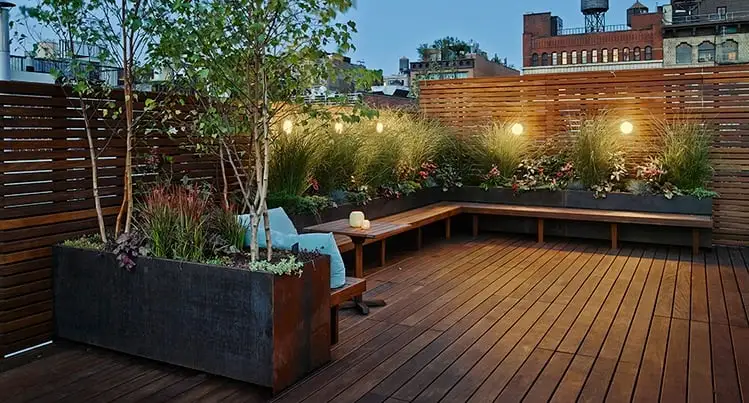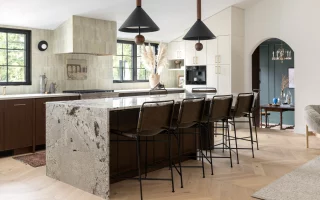Your outdoor space is a blank canvas just waiting to be transformed into your oasis. And what better way to elevate your outdoor living experience than with a stunning deck? Decking not only adds beauty and charm, but it also provides a functional space for you to relax, entertain, and enjoy nature. But with so many decking options available, how do you choose the right one for your outdoor space?
Wood Decking Options:
There are several types of wood decking options available, each with its unique characteristics.
Cedar
Cedar is a popular choice for outdoor deck flooring, and it’s easy to see why. With its natural beauty and durability, cedar decking can transform your outdoor space into a stunning oasis. One of the key advantages of cedar decking is its resistance to decay and rot. Cedar contains natural oils that act as preservatives, making it highly resistant to moisture damage.
Redwood
Redwood is a popular choice for outdoor deck flooring due to its natural beauty and durability. It has a rich, reddish-brown color that adds warmth and elegance to any outdoor space. One of the main advantages of redwood decking is its resistance to rot and decay. This makes it ideal for areas with high moisture levels or frequent rainfall.
Composite Decking:
Durability is one of the main advantages of composite decking. Unlike traditional wood decking, which can warp, crack, and splinter over time, composite boards are designed to resist these issues. They are also resistant to rotting and insect damage, making them a low-maintenance option. Composite decking comes in various colors and styles to suit any design preference.
Materials and Benefits
Its durability and low maintenance make composite decking an attractive choice for outdoor spaces. Made from a combination of wood fibers and recycled plastics, composite decking offers the natural look of wood without the need for staining or sealing. One of the main benefits of composite decking is its resistance to rot, mold, and insects. Unlike traditional wood decking, which can warp or splinter over time, composite decking is designed to withstand harsh weather conditions and heavy foot traffic.
Maintenance and Durability
Maintenance and durability are key factors to consider. With composite decking, you can enjoy a low-maintenance option resistant to rot, warping, and splintering. This means no more sanding or staining! Composite decking is made from wood fibers and recycled plastic materials. It offers the look of real wood without all the upkeep. Plus, it’s available in various colors and finishes to suit any design aesthetic.
Stone or Tile Decking:
One popular choice is natural stone, such as granite or slate. Natural stone provides a timeless appeal and adds a touch of sophistication to any outdoor area. It is also durable and resistant to weather conditions, making it an ideal option for long-lasting deck flooring. Another option is porcelain tile, which offers various design choices. Porcelain tiles come in various colors, patterns, and textures, allowing you to create a custom look for your outdoor space.
Types of Stones/Tiles
One option is natural stone, such as granite or slate. These stones offer a timeless beauty and can withstand the elements without losing their charm. They come in different colors and textures, allowing you to create a personalized look for your deck. Another choice is porcelain tile, which offers a sleek and modern aesthetic. Porcelain tiles are known for their strength and resistance to stains, making them an excellent option for high-traffic areas. They also have low water absorption rates, reducing the risk of cracking due to freezing temperatures.
Pros and Cons
There are several factors to consider. Let’s explore the pros and cons of this option. One of the major advantages of stone or tile decking is its durability. Stone is known for its strength and longevity, making it a great choice for high-traffic areas. Another benefit of stone or tile decking is its aesthetic appeal. With a wide range of options, you can choose from various colors, patterns, and textures to complement your outdoor décor.
Concrete or Pavers:
Concrete offers a sleek and modern look that can complement any home style. It is also incredibly durable and can withstand heavy foot traffic without wearing down. In addition, concrete allows for endless design possibilities as it can be stamped or stained in various patterns and colors. Pavers offer a more rustic and natural look to your outdoor decking area. They come in various shapes, sizes, colors, and textures, allowing you to create unique designs that suit your taste. Pavers are easy to install as they interlock with each other without the need for mortar.
Design Choices
One popular design choice is stamped concrete, which allows you to mimic the look of natural stone or wood without the high cost. With stamped concrete, you can create intricate patterns and textures that add visual interest to your deck. If you want a more rustic feel, consider using brick pavers. These durable materials come in various colors and sizes, allowing you to create unique patterns and designs. Another design choice is exposed aggregate concrete, which features small stones or pebbles embedded in the surface. This creates an interesting texture while providing slip resistance for added safety.
Cost and Maintenance
The cost of installing concrete or paver decking will depend on factors such as the size of your space, the type of material used, and any additional features you may want to incorporate. While initial installation costs can be higher than other options like wood or composite decking, the long-term durability and minimal maintenance make it a worthwhile investment. Concrete decks require periodic sealing to maintain their appearance and protect against stains. This can be done every few years, depending on how much foot traffic your deck receives. Regular cleaning with water and mild soap is usually sufficient for day-to-day maintenance.





